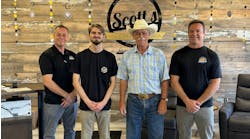Admittedly, I had a tough month recently.
I went down with a severe sinus infection that ultimately degenerated into bronchitis. Fifteen days and two antibiotics later, I was finally starting to feel human again. The upside of recovery is feeling better. The downside is getting back on track while you are still not running on all eight cylinders. Add to that the normal chaos that is our industry and I’m betting you will more than understand why people close to me suggested I wasn’t my normal, charming, patient, lovable self.
Nowhere was that more evident than at the service counter.
However, like Dirty Harry in Magnum Force, I subscribe to the notion that, “A man’s got to know his limitations.” Consequently, I tend to avoid interacting with anything that walks upright and has a pulse when I get like this. It’s just plain better for everyone.
Unfortunately, during this week, avoiding contact was a struggle. In fact, I just about lost that battle completely in one instance.
I was hiding in the office chipping away at the mountain of paperwork on my desk, trying to keep a very low profile, when a black 2002 Dodge Ram 1500 SLT rolled up the driveway. As hard as I tried not to listen to the conversation at the counter, I found myself eavesdropping as our initial set of interview questions were asked and answered.
Everything seemed straightforward enough. The vehicle was in for a coolant leak that was originating at the upper right hand corner of the radiator, according to the owner. He was told we would pressure test the cooling system, verify the leak, estimate the cost of repair and perform our normal, 36-point inspection to ensure the rest of the vehicle was in top shape.
The inspection revealed a leak at the upper righthand corner of the radiator as suggested. But, the Dodge was leaking even more coolant from the lower left corner. There was also evidence of a significant hydraulic fluid leak on the right side of the steering gear, evidence of a leak at the pinion seal, significant enough to create an arc of lubricant and debris across the truck’s undercarriage. The front tires, which were new, were feathering on the outside edges from excessive toe and the spark plugs were worn more than .003 inches over spec.
We estimated the services and repairs the truck’s owner should consider and sent him an electronic copy of both the estimate and the inspection results, which had supporting images of our findings attached.
It was a textbook example of how things should work. A vehicle comes in with a concern, the concern is addressed, the condition identified, captured digitally for confirmation, estimated and then presented to the client.
I was still hiding in the office when the phone rang and it all fell apart. I tried diligently to refrain from getting up from my desk. I tried hard not to get involved. But, when the conversation took an ugly turn and I heard Frank respond repeatedly, “No, the truck was leaking when it got here.
“We did not. ... No, we could not have done anything to cause a leak at the rack. There is an accumulation of residue all over the bellows and tie rod on the right side and the fluid is accumulating and dripping and it looks like it has been for a while.”
Silence …
“No … we didn’t hit anything! Nor is it likely anything hit the rack because of where it is positioned. We sent you digital images of what we found, but why don’t you come down and take a look for yourself? That way you can see what we’re seeing.
“I believe you when you tell me there are no stains on your driveway, but all I can do is communicate what our inspection has revealed and that there is hydraulic fluid inside the bellows, all over the outside, down the tie rod and dripping on the ground.”
Silence …
“No … We’re not asking you to do anything! We’re just sharing what we’ve found—what needs to be done to put the vehicle back in operational condition. It’s your truck and your money! You certainly don’t have to do anything you’re uncomfortable with, anything you don’t want to do.”
This conversation was repeated at least three times as I stood in the doorway and listened. Each time the customer insisted there was nothing wrong with his vehicle and that we had somehow caused the leak. I could feel the muscles in my neck tighten and my blood pressure creep higher.
Moments later the customer appeared. We took him out to the vehicle and showed him what was leaking and where. We showed him the residue and the oil on the bellows.
He showed us a picture of his driveway and insisted there was no leak.
Evidently, I turned a color most humans rarely manage. I told him I wasn’t arguing. But, through gritted teeth and a jaw that was all but locked, I did say, “Then explain that and where it came from, because as you can see it’s been there for a very long time.”
He was backing away as I moved toward him, insisting he wasn’t challenging our expertise, insisting he believed what we were trying to tell him.
I told him what we were doing had nothing to do with whether he believed us or not. All we were doing was demonstrating the physical reality of this particular moment in time—what was and what is.
He stopped, thought about it for a moment, shook Frank’s hand and then authorized the work—all of it. My blood pressure dropped and I went back to hiding out in the office.
Why? Because, this is one man who does know his limitations!




